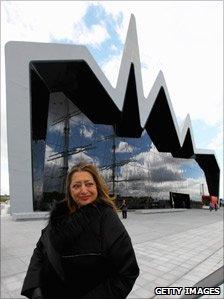Riverside Museum architect visits 'sophisticated shed'
- Published

Architect Zaha Hadid says all 280 of her employees are to visit the museum
Zaha Hadid is half an hour late. Which befits the image of the first lady of architecture but is also very apt.
Despite having worked in the UK for the best part of 30 years, where she's produced many innovative designs, the Riverside Museum in Glasgow is her first major commission to be built in the UK.
But having arrived on the scene late, she and her London-based company seem to be making up for lost time, with a string of iconic buildings due to open in the next 18 months, including the new aquatics centre for the 2012 Olympics.
Critics and public alike admire her buildings' smooth sleek lines. She describes the Glasgow museum as "a sophisticated shed" but its column free interiors and pleated roof provide more than storage.
She admits she'd been to Glasgow before, more than 20 years ago, when a visit to pick up a prize and give a lecture, ended with a tour of the city's nightclubs.
She's won many prizes since then - including being the only woman to win the Pritzker, architecture's answer to the Nobel Prize.
But when her company was picked from 140 submissions to build the £74m Riverside Museum, she recalled the fun element of those nightclubs as well as the more obvious inspiration around the Clyde.
"You only have to look out the window to all these sheds and shipyards, and a site at the meeting of two rivers and one knows so much was made on the Clyde and taken round the world," she says, during a tour of the building.
"But I do remember this was a city with a real sense of fun and people really enjoyed themselves. I hope we brought some of that excitement to the project."
Employee visit
This isn't Zaha Hadid's first project in Scotland. Although smaller in scale and ambition, the Maggie's centre in Kirkcaldy, with its sharp, dynamic edges already gave a sense of what she could do. But after almost 30 years working in the UK, why has it taken so long for her designs to come to fruition.
She shrugs. "I really don't know. There has also been scepticism for whatever reason and it's hard to take a chance on something you don't know. European cities seem more prepared to take a chance of something they don't know, but hopefully all that is changing."
She also believes this is an important flagship for her company, Zaha Hadid Architects. So much so that she's arranged for all 280 of her employees to make a site visit this weekend.
"It's very important for us and nice that it's in this location. The Clyde has been important to us. And to have a second building in Scotland is a great honour."
The building's steel clad exterior and industrial setting has also led to much discussion about whether it's "the Guggenheim of the north" - a reference to the iconic Frank Gehry building which helped change Bilbao's fortunes.

The Riverside is the first major museum to open in Glasgow since The Burrell Collection in 1983
Pistachio colour
Onlookers are quick to point out that Glasgow had already tapped into that effect - thanks to its reign as European city of culture in 1990 - and according to a recent report now employs more people in the cultural sector than it ever did in the shipbuilding trade.
Nevertheless, the new museum is likely to bring additional attention to a city prepared to commission such a bold design.
For now, though, Zaha Hadid has to step back and realise her work is done and that her radical new design is now public property.
"I'm always curious what they're doing with it. But it's their project, it's born, you give it to them and they have to take care of it."
And the infamous pistachio colour scheme, which looks likely to divide public opinion when the building opens on June 21st? Zaha Hadid admits it was her choice - but even she looks like she's having second thoughts.
"It's hard. You're under pressure to come up with something other than white. It's not an art gallery. It needs something radiant and edgy. I hope they like it - if they don't, they can complain to the director but I think, with all these engines, it's going to be ok."
- Published1 June 2011
- Published1 June 2011